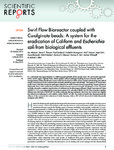Swirl Flow Bioreactor coupled with Cu-alginate beads: A system for the eradication of Coliform and Escherichia coli from biological effluents.
| dc.contributor.author | Atkinson, S | en |
| dc.contributor.author | Thomas, SF | en |
| dc.contributor.author | Goddard, P | en |
| dc.contributor.author | Bransgrove, RM | en |
| dc.contributor.author | Mason, PT | en |
| dc.contributor.author | Oak, A | en |
| dc.contributor.author | Bansode, A | en |
| dc.contributor.author | Patankar, R | en |
| dc.contributor.author | Gleason, ZD | en |
| dc.contributor.author | Sim, MK | en |
| dc.contributor.author | Whitesell, A | en |
| dc.contributor.author | Allen, MJ | en |
| dc.date.accessioned | 2017-05-10T13:37:18Z | |
| dc.date.available | 2017-05-10T13:37:18Z | |
| dc.date.issued | 2015-05-21 | en |
| dc.identifier.uri | http://hdl.handle.net/10026.1/9217 | |
| dc.description.abstract |
It is estimated that approximately 1.1 billion people globally drink unsafe water. We previously reported both a novel copper-alginate bead, which quickly reduces pathogen loading in waste streams and the incorporation of these beads into a novel swirl flow bioreactor (SFB), of low capital and running costs and of simple construction from commercially available plumbing pipes and fittings. The purpose of the present study was to trial this system for pathogen reduction in waste streams from an operating Dewats system in Hinjewadi, Pune, India and in both simulated and real waste streams in Seattle, Washington, USA. The trials in India, showed a complete inactivation of coliforms in the discharged effluent (Mean Log removal Value (MLRV) = 3.51), accompanied by a total inactivation of E. coli with a MLRV of 1.95. The secondary clarifier effluent also showed a 4.38 MLRV in viable coliforms during treatment. However, the system was slightly less effective in reducing E. coli viability, with a MLRV of 1.80. The trials in Seattle also demonstrated the efficacy of the system in the reduction of viable bacteria, with a LRV of 5.67 observed of viable Raoultella terrigena cells (100%). | en |
| dc.format.extent | 9461 - ? | en |
| dc.language | eng | en |
| dc.language.iso | eng | en |
| dc.subject | Alginates | en |
| dc.subject | Biological Oxygen Demand Analysis | en |
| dc.subject | Bioreactors | en |
| dc.subject | Copper | en |
| dc.subject | Enterobacteriaceae | en |
| dc.subject | Escherichia coli | en |
| dc.subject | Glucuronic Acid | en |
| dc.subject | Hexuronic Acids | en |
| dc.subject | Microbial Sensitivity Tests | en |
| dc.subject | Sewage | en |
| dc.subject | Waste Disposal, Fluid | en |
| dc.title | Swirl Flow Bioreactor coupled with Cu-alginate beads: A system for the eradication of Coliform and Escherichia coli from biological effluents. | en |
| dc.type | Journal Article | |
| plymouth.author-url | https://www.ncbi.nlm.nih.gov/pubmed/25999243 | en |
| plymouth.volume | 5 | en |
| plymouth.publication-status | Published online | en |
| plymouth.journal | Sci Rep | en |
| dc.identifier.doi | 10.1038/srep09461 | en |
| plymouth.organisational-group | /Plymouth | |
| plymouth.organisational-group | /Plymouth/Faculty of Science and Engineering | |
| dc.publisher.place | England | en |
| dcterms.dateAccepted | 2015-03-06 | en |
| dc.identifier.eissn | 2045-2322 | en |
| dc.rights.embargoperiod | Not known | en |
| rioxxterms.versionofrecord | 10.1038/srep09461 | en |
| rioxxterms.licenseref.uri | http://www.rioxx.net/licenses/all-rights-reserved | en |
| rioxxterms.licenseref.startdate | 2015-05-21 | en |
| rioxxterms.type | Journal Article/Review | en |


